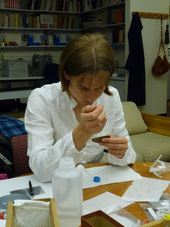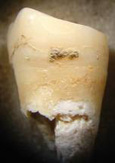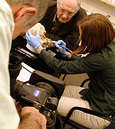Highlight
Plant Microfossils in dental calculus demonstrate consumption of plants and cooked foods in Neanderthal diets
Achievement/Results
A team consisting of IGERT trainee Amanda Henry, and IGERT faculty members Alison Brooks and Dolores Piperno discovered that microfossils of starches from food are preserved for more than 100,000 years in the dental calculus that builds up on teeth if a dentist does not remove it. These starch grain microfossils can be identified by their shape and structural properties to the tribe or family of plants that was consumed and, in some cases, to the genus. A study of starch grains preserved in Neandertal dental calculus revealed that Neandertals ate a wide range of plants throughout most of their range, from Belgium to Iraq. Furthermore some of the starches came from plants that had been cooked. These finding countered earlier arguments that Neandertals were specialized meat-eaters, who were unable to compete against the more generalized Homo sapiens who replaced them. This collaboration brought together a paleobotanist who had previously specialized in the domestication of plant foods, primarily in the New World, and an archaeologist/ palaeoanthropologist specializing in the evolution and geographical spread of Homo sapiens.
Neandertals were the closest relatives of our own species, Homo sapiens. Their lineage survived in Eurasia as far east as Siberia for more than 350,000 years until ca. 35-30,000 years ago, but ultimately died out and was replaced by our direct ancestors coming from Africa. Although Neandertals are often satirized in the media as nasty, brutish or stupid, in fact they were fairly sophisticated hunters of large game, who also fished for shellfish, built fires, made stone-tipped spears, used mineral pigments and buried their dead., among other human practices A recent reconstruction of part of the Neandertal genome from ancient DNA samples has indicated that many genes once thought to be the exclusive preserve of Homo sapiens also were present in Neandertals.
The cause of their demise is much debated. One theory concerning their extinction has focused on differential diets and foraging abilities between Neandertals and Homo sapiens. Stable isotope studies of Neandertals suggested that their bones had very high levels of a heavy isotope of nitrogen, N15 , which is increasingly concentrated as an animal eats higher and higher on the food chain. Neandertals had higher levels then cave bears from the same sites, suggesting to some that they ate almost entirely a meat-based diet, mostly based on the large game animals whose bones were found in the same sites. Homo sapiens on the other hand, was thought to have eaten a wider range of foods including, shellfish, fish and plants, providing them with greater flexibility and thus increased likelihood of success under changing environmental conditions.. The three collaborators set out to test the null hypothesis that Neandertal plant consumption was either nil or extremely limited relative to that of their successors. Rather than looking in cave sediments for plant microfossils such as pollen or phytoliths (small silica bodies formed in plant stems and leaves), they looked for microfossils of starches directly in Neandertal mouths. A previous study had looked for phytoliths on teeth, but had found very few, since most human plant foods are rich in starches but poor in leaves, stems and husks.
The researchers first had to prove to skeptical museum directors and curators of fossils that the method was minimally destructive, removed only a tiny speck of existing calculus, and yielded interesting results that could not be obtained another way. Proof of concept studies were carried out on Neolithic skeletons, showing that the sampling did not damage the dental surface and left most of the calculus in place, that abundant starch grains were preserved up to 5000 years, and that the ancient people in question were part of a larger social system in which they did not eat many of the plants they cultivated, but instead supplied a larger city with foods.
The second obstacle was that very little was known about the wild plant foods eaten thousands of years ago in regions that have been under cultivation for 5000-10,000 years. Henry scoured the literature and the available seed banks and herbaria for possible ancient wild food sources in Europe, Asia, and Africa, raising the plants from seed and harvesting and examining the starch grains from the edible portions. This led to a catalogue of starch microfossils from 388 plant taxa, which will be available online. Finally, since the project involved samples from individuals who had lived up to at least 160,000 years ago, it was necessary to distinguish deliberate food preparation via a large range of possible techniques from alterations of starches due to age or diagenesis. This led to a series of experimental alterations of grains, legumes and tubers (underground storage organs) by every conceivable preparation method, both cooked and raw, to characterize the resultant damage to the starch grains.
Dental calculus was sampled from 33 fossil hominin individuals or dental samples (isolated teeth or groups of teeth), including 10 Neandertals from the Near East and Europe, and 23 early Homo sapiens from the Near East, Europe and Africa. Starch microfossils were sampled from crevices in stone tools at six sites, four of which also yielded some of the dental calculus samples mentioned above. The results suggested that Neandertals ate a wide range of plant foods throughout their range, including grains, tubers and legumes, and that the Homo sapiens who succeeded them did not have a broader plant diet. Additionally, the Iraqi Neandertals appear to have prepared grain, probably a kind of barley, by cooking it in water, and also consumed dates and possibly other tree fruits.
Address Goals
The research made important contributions to the palaeoanthropology of Neandertals, to the study of human evolution generally, and to palaeobotany. In palaeoanthropology, the research demonstrated the effectiveness of an entirely new set of techniques for documenting the evolution of human diets over time, which in turn has implications for current nutritional and medical practices. Palaeobotanical research will be enhanced both by the development of a soon-to-be online catalogue of old world wild plant food starch grains , and by the experimental documentation of how various modes of plant food preparation modify starch grain structures. In addition, the research contributed to the interdisciplinary training of a young researcher, that would not have been possible within a single discipline.
Initial findings from this research were published in the Proceedings of the National Academy of Sciences (Henry, A.G., Brooks, A.S. and D.R. Piperno, Microfossils in calculus demonstrate consumption of plants and cooked foods in Neanderthal diets (Shanidar III, Iraq; Spy I and II, Belgium), Proceedings of the National Academy of Sciences 108 (2): 486-491). They were also discussed in Science’s "Random Samples,
Cavemen craved carbs too Science 331:13).








